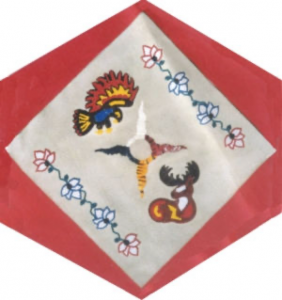Cree Central

The Block
A member of the Cree First Nation, Olga Fortin followed her inner sense of balance and harmony to design and create the Central Cree block. The central symbol, done in the traditional style of flattened and dyed porcupine quills, is the circle of life with the red, black, yellow and white points representing the four races of the world. The floral border, eagle and deer are created using beadwork. The hovering eagle represents spirituality, while the deer is honoured for its life-sustaining gifts.
Cultural Profile
The Cree First Nation is one of Canada’s largest native groups. About 200,000 Cree live across Canada, from the Rocky Mountains to the Atlantic Ocean. There are five major Cree dialects of their Algonquian language. They share a common culture, yet each regional group is distinct. The name Cree is derived from “Kristenaux”, a moniker bestowed upon them by the French. In their own language the Cree refer to themselves as Ayisiniwok, meaning “true men”, or Iiyiyuu, which means “the people”. The Central Cree are also known as the Swampy Cree or Western Woods Cree.
In semi-nomadic fashion, the Central Cree occupied their traditional territory, or Iiyiyuuschii, which extends from James Bay west into Saskatchewan and north along Hudson Bay, as far as Churchill, Manitoba. This region straddles the transition from boreal forests to tundra, and is usually referred to as the Precambrian Shield. Travelling by canoe in summer and snowshoe in winter, they lived off the land’s rich resources, hunting large and small game animals, and fishing. Gathering was primarily limited to indigenous berries that grew seasonally.
During the 18th and 19th centuries their history became inextricably linked with that of the Hudson Bay and the NorthWest fur trading companies. They gradually became more stationary living close to trading posts and mission centres, growing dependent upon European material goods. In the 20th century the Central Cree had to deal with encroaching industries, especially in the mining and forestry arenas.
The Cree First Nation people have kept their language alive by teaching it to their children. Because of this it has one of the highest chances for survival of any Native languages in Canada. Their deep spiritual connection to the land informs core community values of respect for each other and the environment.
Sponsor: O-Pipon-Na Piwin Cree Nation
